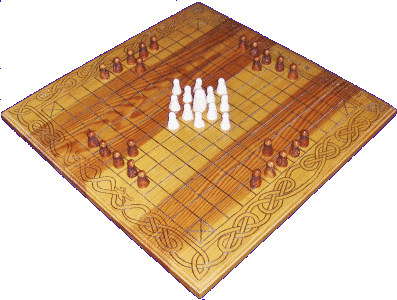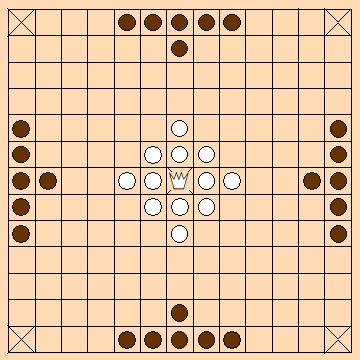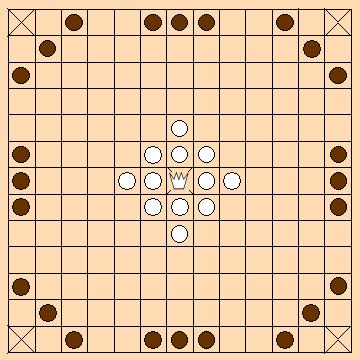

Figure 1. Hnefataflboard
In Earl Rögnvaldr Kali's "Lausavísur" as well as in many other Norse sources a board game called "tafl" is mentioned. In old England a game by the name "tæfl" was known. Also in Old High German texts we can find a game named "zabal".
First the name "tafl"/"zabal" meant "board game" in general. Only after the introduction of chess and backgammon a distinction between "chess" (Old Norse: "skaktafl", Middle High German: "Schachzabel" ), "backgammon" (Old Norse: "kvatrutafl", German: "Wurfzabel"), and King's Table (Old Norse: "Hnefatafl", German: "Königszabel") was carried out. Furthermore the Old Norse term "hnefatafl" contains the word "hnefa" which means "fist", "closed hand", or "thing held in one's closed hand". The Scandinavian "kniv" (knife), English "knife" and German "Knebel" (gag) are cognate with the Old Norse word "hnefa".
Mostly King's Table is played on a board with 13x13 squares. Often this board is also simply called taflboard from Old Norse "taflborð". In the centre of the board the king's throne is situated. Only the king is allowed to walk on the throne. At the beginning of the game the king is placed there sorrounded by his twelve men. The corner squares are the so called burgs. They represent the king's refuges. These refuges, too, are allowed to be walked on only by the king. For both sides, defenders as well as attackers, these burgs count as opposing pieces, what is of great importance in case of the capturing taflstones.
In King's Table in principle two kinds of pieces are distinguished. On the one hand there is the mostly larger shaped king (Old Norse: hnefi, Old English: cyningstan) and on the other hand are the smaller taflmen (Old English: tæfelstanas, Old Norse: töflur, literally "Zabelsteine" in German). In King's Table as well as in chess two sides play against each other. On the one side, or better said in the middle, stands the king with his twelve defenders. His rivals are two dozen taflmen who attack from outside. So, the game is not completely even. The attacking side has no king but twice as many taflmen at its disposal.
At the start of the game the kingstone is placed on his throne in the middle of the board. His twelve men are gathered around him on the surrounding squares. Eight of his defenders are situated on the immediately neighbouring squares. In front of them stands a vanguard in each direction. The attackers are splitted up into four groups of six men and placed like a "T" with a one-man vanguard in front of five men on each edge of the board.

Figure 2. Setup
The defender's goal is to enable the flight of the king onto one of his burgs in the corners of the taflboard. The attackers first aim at foiling the flight. For this the burgs should be besieged at first (figure 3). Over and above that the kingstone should be taken captive.

Figure 3. Laying siege to the corner burgs
-All taflstones only move along a row (left-right) or a column (up-down) like the rook in chess. So, an indefinite number of free squares can be crossed.
-It is not permitted to move in diagonal direction or to jump across one's own or any opposing taflstones.
-Each move has to end on a free square.
-The first move is always carried out by the attackers.
-Zugzwang reigns, that means you are forced to carry out a move in each round.
Opposing taflmen can be captured by trapping or sandwiching one taflstone with the help of two enemy taflmen, that means the three taflstones stand in a row. It is possible to do so both in vertical and in horizontal direction, but not diagonally. There are some special rules to consider.
|
|
Simple Capture of TaflstonesA taflstone can simply be captured by sandwiching it between two opposing taflstones after they had been moved horizontally or vertically immediately next to this taflstone.Trapping a Taflstone with the KingThe king, too, is allowed to take part in capturing or trapping an opposing taflstone this way. |
|
|
Safe Move between Two OpponentsHowever, when a taflstone is moved between two opposing taflstones, this does not count as a capture. On the contrary, the opponent even must spend one additional move to clear the square in order to trap this stone. |
|
|
Capturing at a Corner SquareThe refuges count as opposing taflstones for both 'white' and 'black'. Therefore you need only one taflstone to capture the enemy stone that stands immediately next to such a burg. |
|
|
Double TrapIn case of an appropriate position in the game it is also possible to defeat two opposing taflstones by one move. |
|
|
Double Trap at a BurgAlso by using a corner square that - as already told - counts as an opposing taflstone for both players a double trap is possible. |
|
|
Threefold TrapEven a threefold trap is possible. |
Trapped taflstones are removed from the board afterwards. You are not forced to capture a taflstone.
The game is won when the kingstone is captured by the attackers or when the king succeeded in escaping to one of the burgs.
|
|
Winning by Capturing the KingThe king can be captured on his throne or on any other ordinary square by four opposing taflstones. |
|
|
|
|
|
|
|
|
Winning by Double TrapIf one of the king's men tries to shield his master's flank in order to rescue him from being surrounded, the king's capture is still possible because of the double trap rule even though the second taflstone is sandwiched by opposing taflstones. |
|
|
Winning by the King's FlightWhite wins the game by the king's flight to one of the corner burgs. |
Shieldwallrule means the application of the double trap and the capture of the king on the edge of the board to the ordinary taflmen. The shieldwallrule is used in order to prevent one side, especially the attackers, from resting safe on the edge of the taflboard.
So, if several taflstones with the same colour stand side by side on the edge of the taflboard and one opposing taflman is placed in front of each of them, it is possible to capture the complete row at once by flanking the opposing taflstones. In contrast to the so far explained kinds of capturing the refuges do NOT count as substitute taflstones in this case.
|
|
Capturing by Using the ShieldwallruleIf there is the same number of opposing taflmen in a row in front of a row of taflmen the whole group can be captured at once by bracketing them. |
|
|
No CaptureAccording to the shieldwallrule it is NOT allowed to capture a stone that stands beside a corner burg. Only the king can be taken captive this way (see above). |
The shieldwallrule is rarely used. Rather, it enables the breakup of a row of opposing taflmen on the edge of the board by forming a row with one's own taflstones because the other player wants to avoid the loss of several taflstones at once.
These rows facing each other remind of a shieldwall, a viking battle formation, the rule is called after.